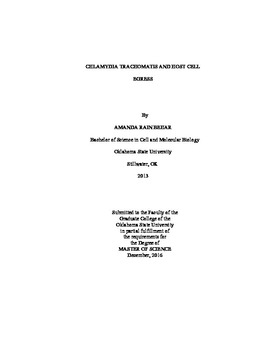| dc.contributor.advisor | Lutter, Erika I. | |
| dc.contributor.author | Behar, Amanda Rain | |
| dc.date.accessioned | 2018-06-25T16:31:13Z | |
| dc.date.available | 2018-06-25T16:31:13Z | |
| dc.date.issued | 2016-12-01 | |
| dc.identifier.uri | https://hdl.handle.net/11244/300284 | |
| dc.description.abstract | Chlamydia trachomatis is the most frequently reported bacterial sexually transmitted infection worldwide. Even after a C. trachomatis infection is treated, there is an increased risk for the development of pelvic inflammatory disease and cervical cancer, but the underlying mechanisms are poorly understood. C. trachomatis usurps many host cell-signaling pathways from within a membrane bound vacuole, called an inclusion. C. trachomatis is also known to synthesize and secrete via the type III secretion system, inclusion membrane proteins (Incs) that are inserted into the inclusion membrane and serve as the interface between Chlamydia and the host. C. trachomatis is the first bacterial pathogen observed to recruit myosin phosphatase (MYPT1) for means of host cell exit, by extrusion, and does so through the chlamydial Inc protein, CT228. In this study the chlamydial TargeTronTM system was used to genetically inactivate CT228 in the C. trachomatis genome and genetically perform complementation of CT228 in trans to successfully restore MYPT1 recruitment in the mutant. Currently, in vivo models of infection continue to be instrumental in elucidating the pathogenesis of and immune response to this intracellular bacterium, however significant gaps in our understanding exist when utilizing such. The second objective of this study was to produce a side-by-side comparative analysis in a cervicovaginal murine infection model utilizing the C. trachomatis serovars D and L2 and the C. muridarum strain, MoPn, by characterizing the time course of infection and Chlamydia shed and obtaining gross pathology following clearance of active infection. A key finding herein is the first identification of chlamydial extrusions shed from host cells in an in vivo model. Extrusions, a phenotype made possible through a dynamic involving CT228 and MYPT1, had been previously observed solely in vitro. The results of this study demonstrate that chlamydial extrusions exist in vivo, representing a possible host dissemination method, thus warranting further investigation to determine their role in chlamydial pathogenesis. | |
| dc.format | application/pdf | |
| dc.language | en_US | |
| dc.rights | Copyright is held by the author who has granted the Oklahoma State University Library the non-exclusive right to share this material in its institutional repository. Contact Digital Library Services at lib-dls@okstate.edu or 405-744-9161 for the permission policy on the use, reproduction or distribution of this material. | |
| dc.title | Chlamydia Trachomatis and Host Cell Egress | |
| dc.contributor.committeeMember | Shaw, Edward | |
| dc.contributor.committeeMember | Oomens, Antonius | |
| dc.contributor.committeeMember | Hadwiger, Jeff | |
| dc.contributor.committeeMember | Shaw, Jennifer H. | |
| osu.filename | Behar_okstate_0664M_14881.pdf | |
| osu.accesstype | Open Access | |
| dc.description.department | Microbiology, Cell, & Molecular Biology | |
| dc.type.genre | Thesis | |
| dc.type.material | text | |
